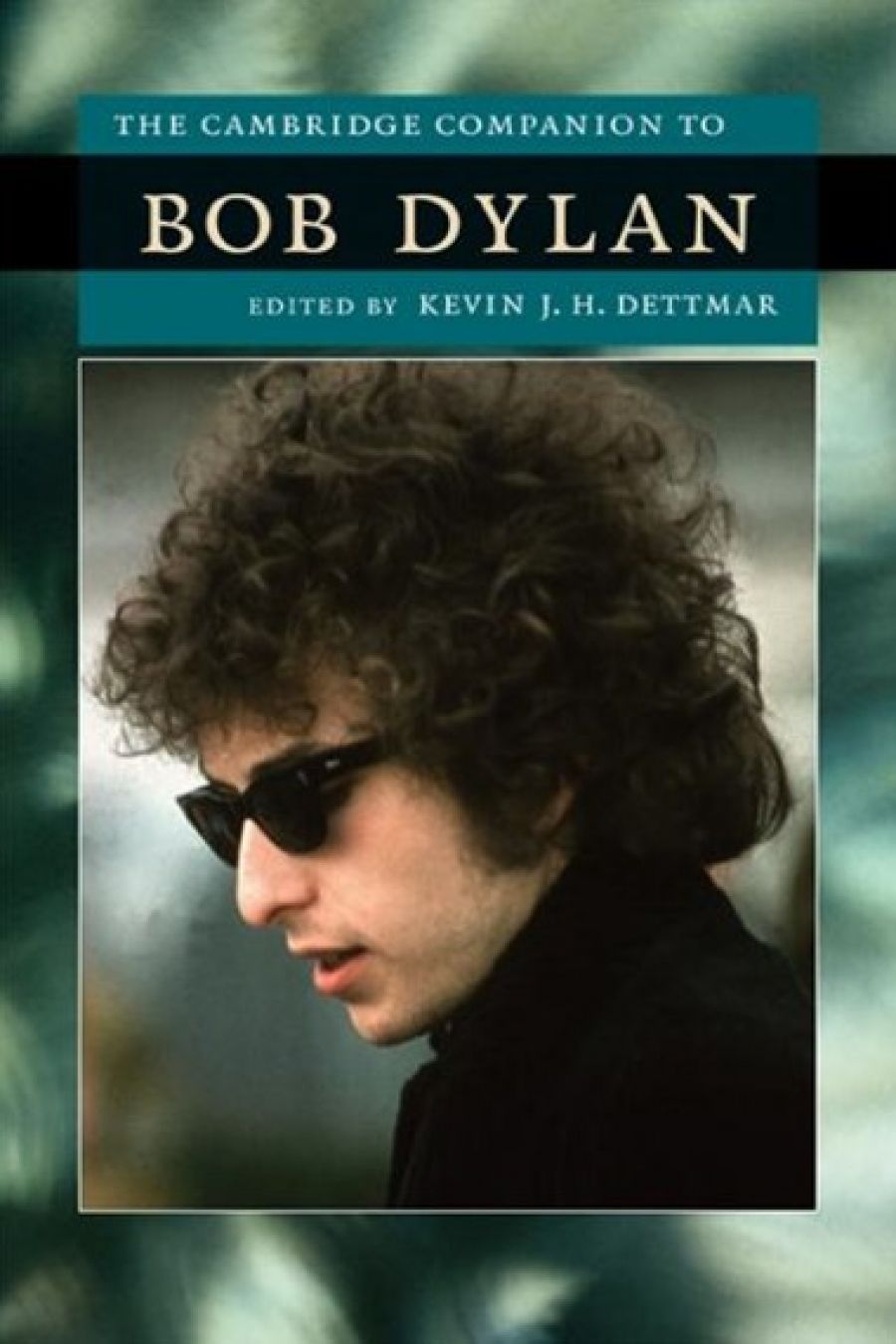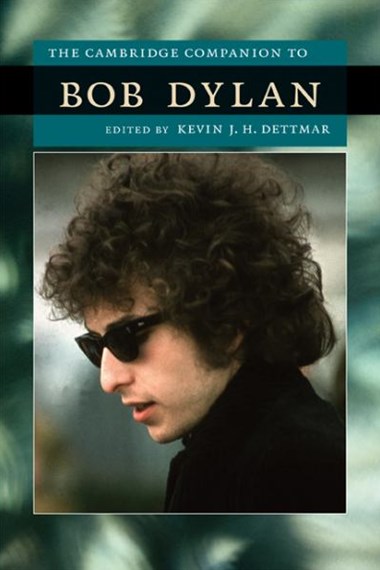
- Free Article: No
- Contents Category: Music
- Review Article: Yes
- Article Title: The concept that dare not speak its name
- Online Only: No
- Custom Highlight Text:
Following years of debates with people who denied that Bob Dylan was worthy of serious literary study, I eventually conceded, albeit in a somewhat roundabout fashion. Having brought enjoyment and illumination to millions of people, what on earth had Dylan done to deserve being beaten about the head by literary criticism? But after a hiatus, The Cambridge Companion to Bob Dylan has brought me up to date with the field of Dylan studies, and I can confidently declare that there is hope. This collection consists of nine ‘big picture’ essays on subjects such as Dylan as songwriter, Dylan and collaboration, Dylan and gender, and so on, followed by shorter pieces on eight of Dylan’s most influential albums (how they chose from the fifty-odd on offer is anyone’s guess).
- Book 1 Title: The Cambridge Companion to Bob Dylan
- Book 1 Biblio: Cambridge University Press, $39.95 pb, 185 pp
- Book 1 Cover Small (400 x 600):

- Book 1 Cover (800 x 1200):

A number of the contributors, including editor Kevin J.H. Dettmar in his introduction, ponder the odd trajectory of Dylan studies. Dettmar points out that no other figure in the history of American popular music has attracted as much critical attention as Dylan. The very existence of a Cambridge Companion, of course, testifies to this: it is difficult to imagine subsequent volumes devoted to Eric Clapton or Jimi Hendrix, to say nothing of Britney Spears. But Dettmar believes that in the ‘revitalized, democratic and demotic environment’ engendered in universities by the rise of cultural studies, Dylan will be more intensely studied, and better understood, than ever: ‘His songs provide a wonderful set of texts in which to explore issues of intertextuality, irony, the rhetoric of political action, the limitations of formalist analysis, modernist textuality, the congruence of modern authorship and celebrity, and autoethnography.’ (I have been out of the game too long to tell you what ‘autoethnography’ involves.)
But Dettmar’s sense of a brave new world of Dylan studies is heavily qualified by Lee Marshall in his essay on ‘Bob Dylan and the Academy’, which rang far truer to my experiences of a decade ago, somewhat depressingly so. Marshall explains how Dylan has received a bum deal from criticism, at both ends of his career. Dylan lobs in universities in the 1960s, when the New Criticism’s focus on close textual analysis is at its peak. The result is that Dylan’s lyrics get picked apart as if they were poems by Donne or Marvell: a level of attention they cannot sustain, not because they are not as good as Donne and Marvell, but because they are nothing like Donne or Marvell. Meanwhile, the performative elements of Dylan’s art – not just the music, but the presence of the singer himself – are overlooked.
The situation is little better, Marshall argues, in the era of cultural studies. While cultural studies is certainly open to the study of a performative art such as Dylan’s, it is obsessed with contextualising and historicising notions of canonicity. Cultural studies wants to view a rock star’s public presence as the confluence of commercial, political and media forces. Does that seriously strike anyone as explaining Dylan? The result, says Marshall, is that cultural studies is struck dumb by Dylan’s, well, greatness:
Although there have been tentative steps toward considering issues of quality in cultural studies, aesthetic excellence is still the concept that dare not speak its name in cultural studies. Scholars are still far more likely to find something intellectually worthwhile because of its polysemous and ‘resistant’ possibilities rather than because it is any good.
Another way of putting it would be to say that textual analysis and cultural studies have both thrown some light on Dylan, while ignoring the reasons we find him compelling in the first place. Happily, the contributors to the Cambridge Companion are much less embarrassed than their academic ancestors by Dylan’s hold on ‘aesthetic excellence’, or by his sheer charisma, and, as a result, insights abound through-out the volume.
In ‘Bob Dylan As Performer’, for example, Alan Light points out that Dylan’s endless remaking of his songs in concert demonstrates that ‘his songs aren’t permanently fixed museum pieces’, a key insight that, if it were articulated at length, would go a long way toward revealing why Dylan is a different kind of artist from even the best of his singer–songwriter contemporaries. In ‘Bob Dylan and the Anglo-American Tradition’, David Yaffe reveals something of the extraordinary bricolage that Dylan has woven from his musical and literary sources. Anthony Decurtis, in ‘Bob Dylan As Songwriter’, usefully trashes the notion that Dylan ever wrote simplistic protest songs, while, in ‘Bob Dylan and Religion’, R. Clifton Spargo and Anne K. Ream make the accompanying observation that Dylan’s work was shot through with religious symbolism and connotation long before he converted to Christianity: ‘Even without the rebirth of 1979, Jewish and Christian idioms persist in his work to such a degree that Dylan would have to be reckoned one of the most powerful interpreters of religious language and sensibility in all of American pop culture.’
All true, but with such a variety of critical approaches on offer, it is disappointing that Dylan has still not been subjected, in any systematic way, to criticism based on mythic stories and characters – in other words, to archetypal criticism. Dylan’s is a mythic imagination, like Blake’s or Whitman’s, which is why close textual criticism has dealt poorly with him, just as it deals poorly with Blake and Whitman.
It is not as if Dylan hasn’t dropped frequent hints that in fable and mythology are to be found the keys to his imagination. For example, explaining the early allure of folk music in his free-form memoir, Chronicles (2004), he describes it as a ‘mythical realm made up not with individuals so much as archetypes, vividly drawn archetypes of humanity, metaphysical in shape, each rugged soul filled with natural wisdom and inner knowing’. He continues: ‘I could believe in the full spectrum of it and sing about it. It was so real, so more true to life than life itself. It was life magnified.’ That, to me, suggests what the beginnings of a full-scale account of Dylan would look like: the study of a deeply traditional, religio-mythic temperament that emerges from mainstream American transcendentalism.
These minor reservations aside, however, the essays collected in The Cambridge Companion to Bob Dylan make a lively, enjoyable and informative contribution to our understanding of the world’s most influential living cultural figure. Perhaps Dylan deserves academic study, after all.


Comments powered by CComment